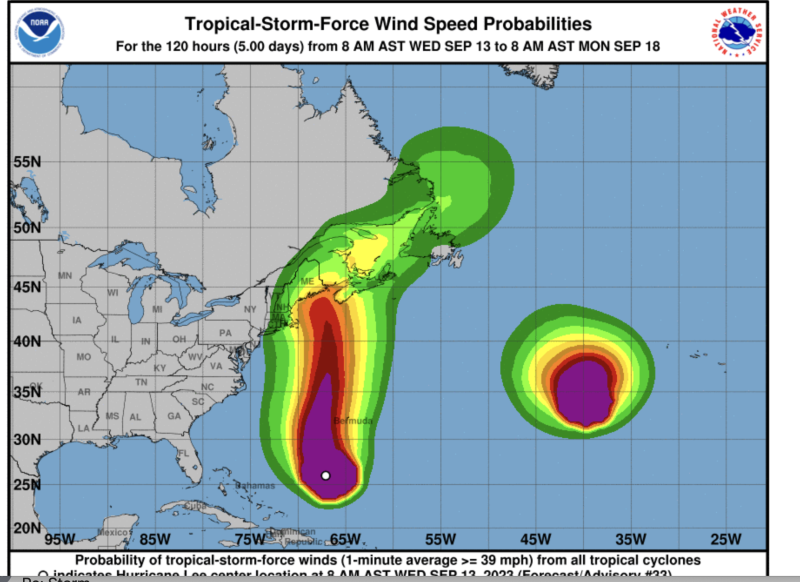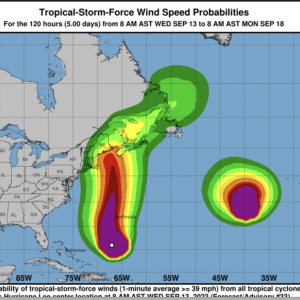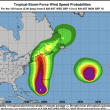How to get prepared for Hurricane Lee on Saturday
The latest report from the National Weather Service regarding Hurricane Lee is calling for tropical storm conditions tonight into tomorrow in the Midcoast with high surf, and rainfall amounts of 1 to 3 inches with gusts predicted up to 50 m.p.h. With the excessive rain we’ve had this summer causing root stress in trees, there is a major potential for falling trees and power outages. Today, residents still have time to get prepared.
Following is the National Weather Service forecast for the weekend.
Friday —Mostly cloudy, with a high near 71. Northeast wind 5 to 10 mph. A 30-percent chance of showers, mainly after 3 a.m. Cloudy, with a low around 59. Breezy, with a north wind 10 to 20 mph, with gusts as high as 35 mph. New precipitation amounts of less than a tenth of an inch possible.
Saturday—Showers likely, mainly between 7 a.m. and 4 p.m. Cloudy, with a high near 68. Windy, with a northwest wind 25 to 30 mph, with gusts as high as 50 mph. Chance of precipitation is 70%. New precipitation amounts between a quarter and half of an inch possible.
To listen to live NOAA Weather Radio, visit wunderground.com.
- Secure loose gutters and shutters.
- Identify an interior room of your house, such as a basement or interior bathroom, that you can take shelter in during high wind warnings.
- If you live in a mobile home, identify a sturdy building you can go to if NWS issues a high wind or severe thunderstorm warning.
- Tie down or put away items in your yard so that they don't blow away or fly through a window.
Car
- Move your car to a location where it is less likely to be hit by falling trees or power lines
- Prepare an evacuation route and get a full tank of gas.
- Store a basic disaster kit or emergency supply kit in your trunk.
- Ensure windshield wipers are in good shape and that you inflate your tires properly.
- Place all important documents in a waterproof bag and take them with you.
- Charge your cell phone and plan to bring it if you evacuate.
- If you expect to leave your car behind, be sure it’s not in a flood-prone area. Rising water can seep in and damage your vehicle.
Pets
- Choose a safe place where your pets can go if you need to evacuate or seek shelters such as a friend or family member’s home, a pet-friendly hotel, or a boarding facility.
- Choose a safe room for riding out the storm—an interior room without windows – and take your entire family there, including your pets.
- Stay with pets. If crated, they depend on you for food and water. Don’t leave pets in vehicles.
- Know your pet’s hiding places. That’s where they may run, so make sure to keep them with you.
- Secure exits and cat doors so pets can’t escape into the storm.Double-check emergency supplies – including, medications, bowls, water, and food
- Do not tranquilize your pets. They’ll need their survival instincts, should the storm require that.
Maine EMA has provided the following tips:
Steps people can take to prepare for the storm include:
- Check that your emergency kit includes supplies needed for several days without power, including food, water, and hand sanitizer. Also consider medications, pet food or other special needs.
- Get the latest alerts and warnings on your smartphone by downloading the free FEMA app or National Weather Service website.
- Ensure cell phones are enabled to receive National Weather Service Wireless Emergency Alerts for tornadoes, flash flooding and other emergency situations.
- Charge cell phones and other electronic devices.
- Determine local evacuation routes.
- Bring in all outdoor furniture, decorations, garbage cans and anything else that is not tied down.
- Remove boats and other watercraft from the water and secure them.
- Ensure generators are properly installed, fueled, and in good working order.
In the event of flooding, do not walk, swim, or drive through flood waters. Turn Around. Don't Drown! Just six inches of fast-moving water can knock you down, and one food of moving water can sweep your vehicle away.
Prepare for a power outage:
- Find Alternate Power Sources. Plan for batteries and alternative power sources to meet your needs when the power goes out, such as a portable charger or power bank. Have flashlights for every household member. Remember, never use a generator indoors.
- Appliances. Disconnect appliances and electronics to avoid damage from electrical surges. Install carbon monoxide detectors with battery backup in central locations on every level of your home to avoid carbon monoxide poisoning.
- Food Storage. Keep freezers and refrigerators closed. A refrigerator will keep cold for four hours. A full freezer will keep the temperature for about 48 hours. If you are in doubt, monitor temperatures with a thermometer and throw out food if the temperature is 40 degrees or higher.
- Know Your Medical Needs. If you rely on electricity for any medical needs, make a power outage plan for medical devices or refrigerated medicines. Find out how long medication can be stored at higher temperatures and get specific guidance for any medications that are critical for life.
- Cleanup. After power and other utilities have been restored, you might face the issue of what to do with storm-damaged trees. Maine Forest Service offers tips and helpful guidance for those faced with questions about what to do with downed trees, limbs, and branches.
Hurricane season runs June 1 - November 30. Please visit Maine Emergency Management Agency on Facebook or Twitter.
























